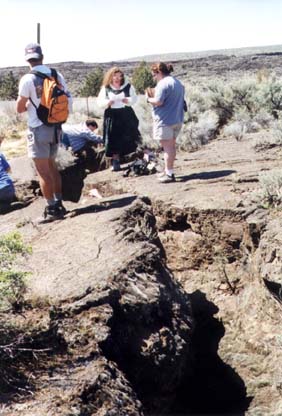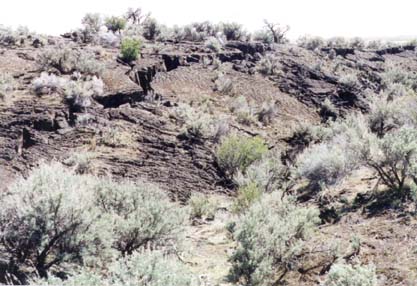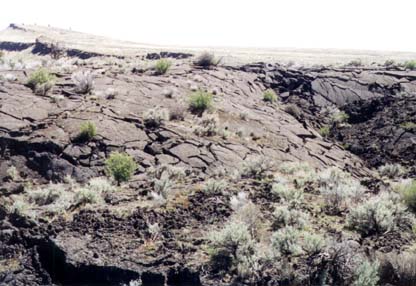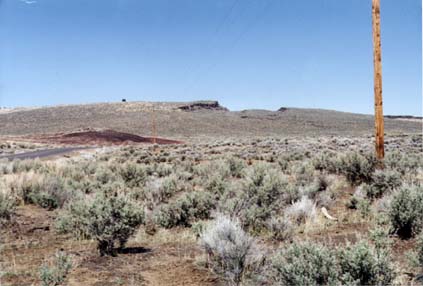

D iamond Craters is a complex of multiple volcanic vents, craters, cones, and other lava events within a large caldera. These began erupting 17,000 to 15,000 years ago, one of the youngest eruptions in southeastern Oregon. Periods of quiet were punctuated by phases of explosive and dramatic blowouts.
Stop 4: Lava Flows
LEFT PHOTO: We study the features of well preserved pahoehoe lava, tumulus, and collapsed lava tubes.
BELOW: The pahoehoe lava is like broken slabs of ashphalt. This formation appears to be a pressure ridge.

The Diamond Craters area is located about 18 miles due south of the Malheur Field Station in the same basin. It erupted at the edge of the Steens Mountain foot block perhaps along a transverse fault of the Steens horst.
 Pahoehoe is distinguished by its smooth, wrinkled, ropy or baloon-like surface. These are formed by very runny flowing lava. Conditions can cause these kinds of molten rock to pool or flow at even rates over long periods of time,allowing a skin or crust to form which will often support itself after the flow has drained from the casting. Lava tubes of such construction vary from a few inches in diameter to the size of an Interstate highway tunnel. See Malheur Cave.
Pahoehoe is distinguished by its smooth, wrinkled, ropy or baloon-like surface. These are formed by very runny flowing lava. Conditions can cause these kinds of molten rock to pool or flow at even rates over long periods of time,allowing a skin or crust to form which will often support itself after the flow has drained from the casting. Lava tubes of such construction vary from a few inches in diameter to the size of an Interstate highway tunnel. See Malheur Cave.
Graben Dome can be seen on the horizon. Here the lava intruded beneath a thick layer of lava from an earlier phase of eruptions and pushed up a dome. The molten lava then broke through the side of the dome and drained away. Portions of the unsupported dome collapsed back into the chamber.
 We moved on to STOP 6. STOP 5 was rebuilt to a simulation of what it once looked like before the cinders were hauled away for construction purposes. True geologists that we are, we drove past the man-made volcanic.
We moved on to STOP 6. STOP 5 was rebuilt to a simulation of what it once looked like before the cinders were hauled away for construction purposes. True geologists that we are, we drove past the man-made volcanic.
There are three red cinder craters on this South Dome portion of the caldera. The cinders were quarried from this site before the value of this natural area was fully recognized.
An exposure of Devine Canyon Ash-flow Tuff forms a wall outcrop which was isolated by Diamond Crater Basalt Flows leaving the older formation as an island above the younger lava. Such islands are called kipuka.
